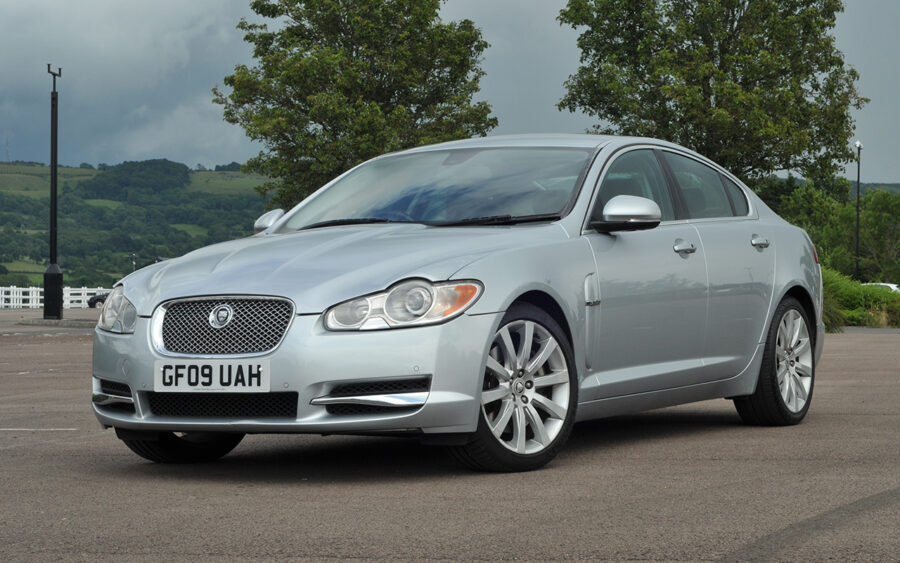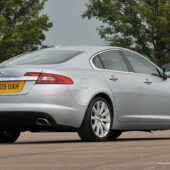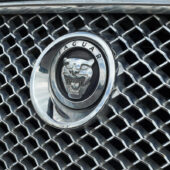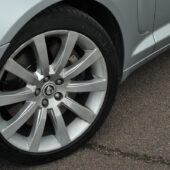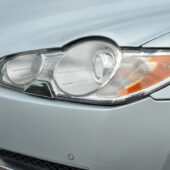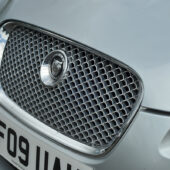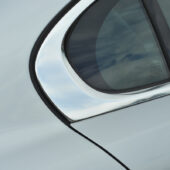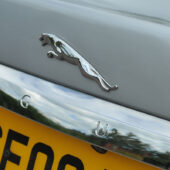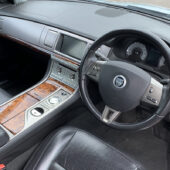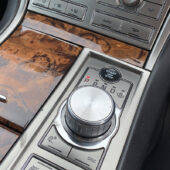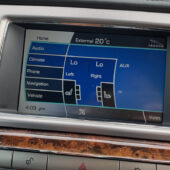The Jaguar XF was the car that helped steer the brand in a more modern design direction, challenging its German rivals head-on. Here’s how to buy one today
Words: Rob Hawkins
The XF got off to a fantastic start for Jaguar when it replaced the S-Type in 2008. Rave reviews from the automotive press were joined by an enthusiastic response from buyers and enthusiasts alike.
Coming with rear-wheel drive, the initial choice of engines included the petrol 3.0-litre V6 and 4.2-litre V8 (including 410bhp supercharged), plus the well-known 2.7-litre V6 diesel developed by Ford, Peugeot and Citroen. By March 2009, the V8 engine had been stretched to 5.0 litres and the 2.7-litre TDV6 had been replaced with the larger 3.0-litre unit (still diesel).
A minor Jaguar XF facelift arrived in 2012 along with the Sportbrake estate, and Ford’s 2.2-litre turbocharged diesel engine was introduced in place of the 2.7D, although the larger 3.0-litre diesel remained. The naturally aspirated V8 was replaced with a supercharged 3.0-litre V6, but the supercharged V8 continued and, throughout the car’s production life, the likes of the Jaguar XF R, XF R-S and XFR have been a match for the BMW M5 and AMG Mercedes. Boasting 502 to 542bhp with sub-five second 0-60mph times, these V8-powered saloons are still highly desirable, providing you can accommodate fuel consumption in the low 20s and hefty road tax payments.
It is perhaps obvious to see why the Jaguar XF was such a huge hit. From a practical viewpoint, the saloon can swallow 540 litres of luggage in the boot – 550-565 litres for the Sportbrake with the rear seats up, or 1,675 litres with them down, which is more than a BMW 5 Series Touring or Mercedes W218 estate.
The Jaguar XF’s performance figures are breathtaking and, for the frugal, the diesel engine models make economic sense. Take the entry-level 2.2D Ford engine XF with 160bhp at the flywheel and average fuel consumption of up to 57mpg: a full tank (a modest 64 litres) can clock up 803 miles. By 2015, a further set of revisions included a range of smaller 2.0-litre petrol and diesel engines, and an all-wheel-drive version for the USA.
We’ve carefully researched all the potential problems that may arise with owning a Jaguar XF but, as Matt Norbury at North Wales Jag Centre says, “Pound for pound, the XF is one of the best cars, if not the best, you could buy in today’s market. They have their niggles, as does anything, but nip any issues in the bud and you’ll keep maintenance costs down to that of your average VW Passat or 3 Series BMW.”
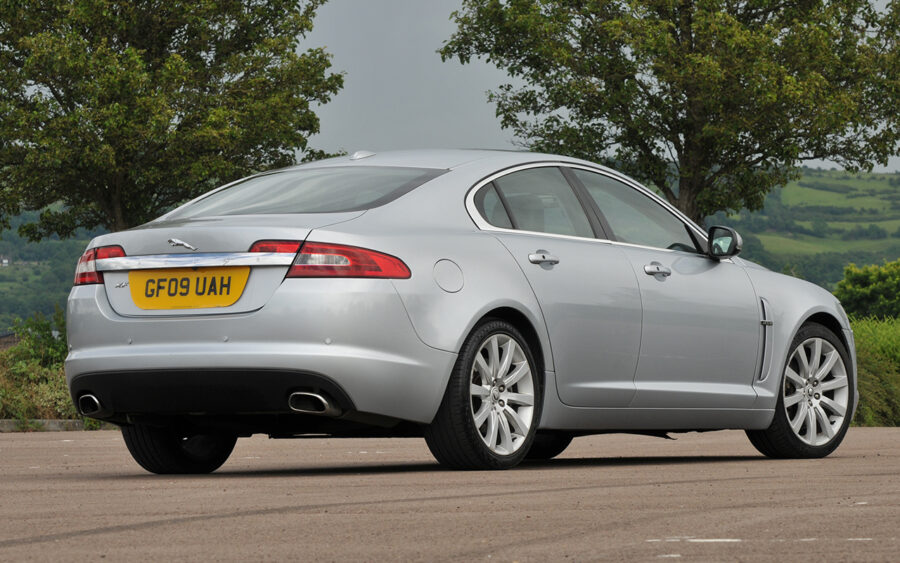
Bodywork
Being almost five metres long and a little over two metres wide, Jaguar XF owners can be forgiven for a few bodywork scratches. Fortunately, most panels can be removed without any major bodywork surgery, although their fittings may sometimes need to be discarded. The sill covers, for instance, are secured with plastic trim screws that can round off and may need to be drilled or pulled out and replaced.
Elsewhere, the bumpers, wings and aluminium bonnet can all be removed and replaced. The chrome-looking trim around the doors can turn milky, but it is possible to replace it.
We never like to tempt fate but the XF doesn’t seem to be plagued with the sort of rust problems that have killed off many an X-Type and S-Type. Surface corrosion of the rear subframe and its brace bars appear to be the worst problems so far.
Niggling problems do arise, such as the battery clamp in the boot – its fixings are exposed and inevitably corrode, resulting in a battery replacement taking a lot longer than expected. It’s worth regularly cleaning and greasing this thread.
The exhaust may corrode, but we’ve yet to hear of this resulting in leaks. Similarly, the bottom of the suspension dampers can become covered in surface corrosion, but we’ve not seen any that have rusted through.
Engine and transmission
Most of the vital engine-related fluids can be checked from inside the engine bay. The coolant level can be visually checked via the expansion tank on the nearside rear corner of the engine bay (on late models), or at the front of the engine bay. Look at the side of the plastic expansion tank to check the level.
Some Jaguar XF engines have a traditional dipstick to check the engine oil level. On others, the level is checked via the dashboard controls, in which case do not run the engine or switch on the ignition for 15 minutes pre-check. Switch on the ignition after this time, but still do not run the engine, and operate the controls for the instrument display until a reading appears for the engine oil level. If a message appears referring to the handbook, switch off and allow another 15 minutes or more before checking again.
Pink-coloured coolant should be used and can be tested with a hydrometer to measure its freezing capacity. The expansion tank can fracture and leak coolant around the bleed pipe outlet. Budget for around £90 for a new expansion tank, or £30 for a used one.
Tom Lenthall Ltd has found that the plastic coolant housing in the middle of the vee on 2.7- and 3.0-litre diesel engines can crack and leak. Plus, the water pump outlet on the left (nearside) of the engine block can leak on these engines.
Check the level in the power steering fluid reservoir, located on the nearside of the engine bay, by looking at the maximum and minimum markings on the side of the plastic reservoir. Top up with Dexron III power steering fluid, or whatever has been used before.
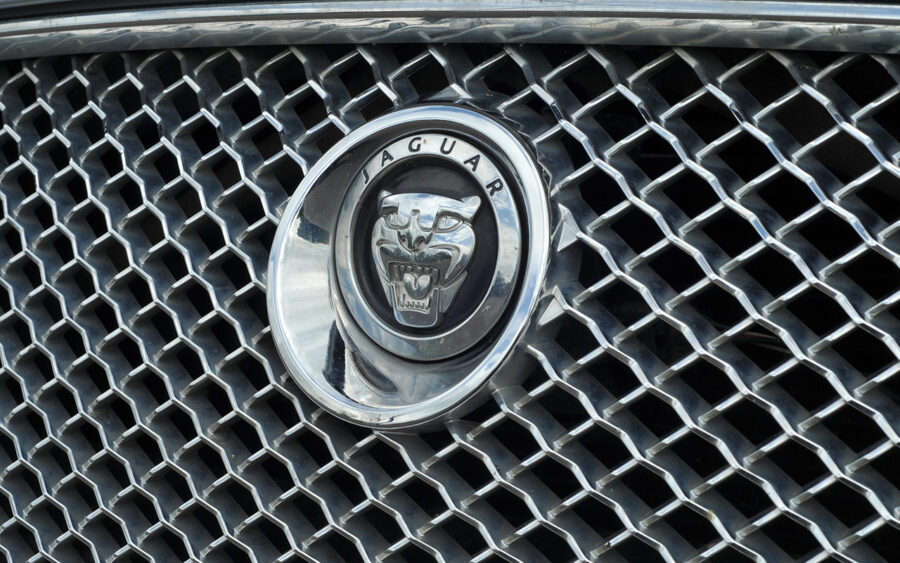
The windscreen washer reservoir’s filler neck is located on the offside of the inner wing – the reservoir is located below, inside the A-post area of the wing.
The brake fluid reservoir is at the offside back of the engine bay. In some cases, it’s underneath a plastic grille panel, which needs to be released to allow you to inspect the level on the side of the translucent reservoir. Top up with DOT 4 brake fluid, or whatever has been used before (Elite & Performance Jags recommends using DOT 5.1).
Auto Reserve told us that the MAP sensor on the 2.7- and 3.0-litre diesel engine can become clogged with carbon deposits and oil, resulting in a fault code. There’s one on the top of the engine, as shown here, which is secured with a Torx T25 screw, and can be extracted and gently cleaned. If cleaning the MAP sensor doesn’t work, it’s worth sourcing a used one.
Matt Norbury, at North Wales Jag Centre, has an alternative solution, explaining, “The early 2.7 diesels are the only ones that suffer MAP sensor issues, due to the diameter of the hole on the sensor that monitors manifold pressure. The cure is to fit a 3.0D MAP sensor, as the diameter of the sensor hole is about four times as big. A new one costs around £90.”
Look out for blocked engine breathers on the 4.2-litre petrol V8, resulting in oil being sprayed around. On the petrol V6, the breather pipe fitted to the throttle body (which circulates oil vapours) can break down inside, resulting in a fault code and the engine management light illuminating on the dashboard.
All diesel engines are equipped with a diesel particulate filter (DPF), and DPF-related fault codes may arise. Running the engine at above 40mph for 45 miles often regenerates it. It’s also essential to frequently check the engine oil level and make sure it doesn’t go beyond three-quarters full (MAX). This provides a safety margin should a DPF regen start but not finish in time (resulting in fuel being dumped into the engine oil). If the engine oil became overfull as a result, there is a risk of engine failure. Using the correct DPF-specific engine oil is essential, and short runs and town driving should be regularly mixed with a long drive down a motorway or major A-road.
Diesel engine turbo failure on the 2.7 is seemingly a common issue, often due to carbon deposits on the variable veins. “I’ve not long had to do the two on my wife’s XF,” says Matt Norbury, at North Wales Jag Centre. “Being the only model with twin variable vein turbos, they unfortunately pose issues, as whatever you do to one you inevitably have to do to the other.”
The 2.7-litre TDV6 is the least popular engine for the XF having gained a poor reputation for failure. Excessive oil levels, as mentioned above, appear to be one of the causes, sometimes after a failed DPF regen. Poor and infrequent servicing is another cause, so it pays not to miss this important part of car ownership. As Matt Norbury testifies, “My wife’s 2.7 diesel XF has just clocked 235,000 miles and is still on its original engine. I have looked after this car from 30,000 miles with its previous owner.”
When a 2.7-litre TDV6 engine does fail, the oil pump may cause the initial trouble, resulting in poor oil circulation and pressure, leading to main and big-end bearing failure. The most cost-effective solution, should you want another engine, is to buy second-hand (£1,100 from Auto Reserve). The same engine from the S-TYPE can also be fitted, although ancillaries need to be swapped over and changes made to the wiring loom.
Elite & Performance Jags has found the inlet manifolds and camshaft covers on the 3.0-litre diesel have cracked, resulting in restricted performance, and that the turbos’ shut-off valves can fail.
Alternator failure may be a common problem on the 2.2D, 2.7D and 3.0-litre diesel engine XF (alternators on petrol engines appear to be more reliable). According to Auto Reserve the cause of the problem is the voltage regulator, while Tom Lenthall has found clutch failure inside the alternator to be a common cause, saying, “We only advise replacing with genuine parts on this item. We have had multiple failures of aftermarket alternators days after fitting.”
The emissions-related exhaust gas recirculation (EGR) valve returns waste gases to the induction system with the intention of reducing pollution. As a result, carbon and oil vapour from these waste gases coat the inside of the EGR valve and eventually it clogs up and fails, raising a fault code. On the XF 2.2D, the coolant-fed EGR cooler can also be affected, which adds another £400 to the final bill, but it’s not always the case.
However, it’s worthwhile being cautious with replacing an EGR valve, so Jaguar insists on renewing the steel pipe that’s routed between it and the throttle body to maintain the warranty on a new EGR valve. Budget for around £800 for a specialist to complete this job.
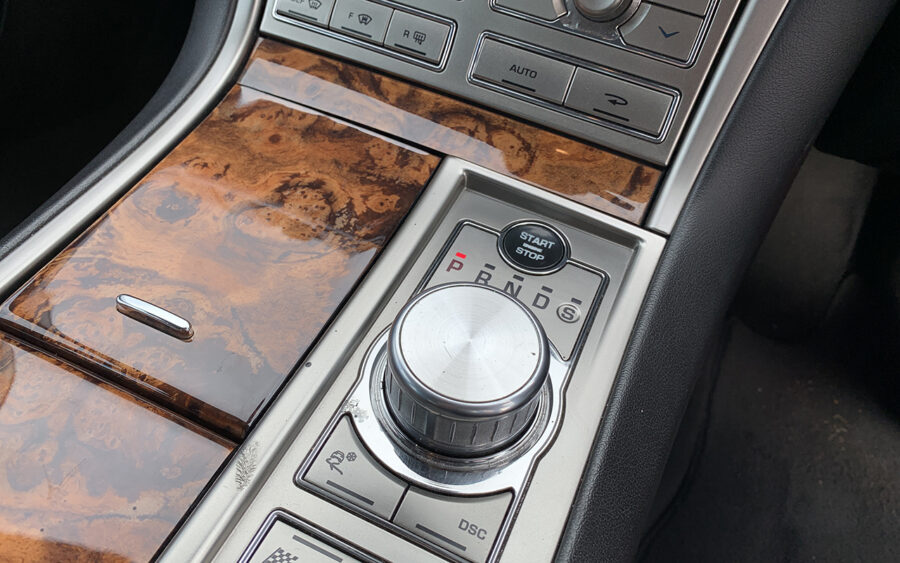
The majority of Jaguar XFs have either a six-speed ZF 6HP26 automatic gearbox that was initially fitted or the later eight-speed automatic. Manual gearboxes were introduced on the latest 2.0D models from around 2016.
The ZF’s automatic ’box has a plastic sump, so check for leaks from damage and warping. This is supposed to be sealed for life, but most specialists recommend an oil and filter service every 70,000 miles. The gear selector is known to fail but replacements are available.
On diesel XFs, a water-cooled oil cooler for the gearbox can fracture internally. An initial indication of the problem is if the car judders under gentle load when driving uphill. The answer is to have it fixed before the gearbox fails by replacing the oil cooler and having the gearbox oil and filter renewed.
The Jaguar XF’s differential is mounted in the rear subframe and can lose its oil if a breather becomes blocked (Eurojag has also found them to become noisy through bearing wear). The diff’s oil level can be checked by undoing its inspection and filler plug with a 3/8in ratchet.
Suspension, steering and brakes
Disc brakes are fitted all round on the Jaguar XF, and, in most cases, are a conventional single-piston type with 7mm or 9mm Allen key slider bolts. Spring clips are fitted against the outer brake pads, which must be fitted to pass the MOT test. Wear sensors are fitted to the offside rear and nearside front brake pads, and cost around £40 each. These can be delicate and will need to be replaced if the pads have become sufficiently worn to activate the warning light on the dashboard.
Before any work can be conducted on the rear brakes, the electronic park brake must be put into service mode, which must be completed using diagnostic equipment to avoid injury or damaging any parts through activating the handbrake when working on the rear brakes.
On early XFs, old brake discs can become seized onto the mating surface of the hub, requiring the use of a puller to remove it, or a lump hammer (wear safety goggles, ear plugs and gloves) to tap the front and rear faces of the disc. The problem is down to the mating surface on the hub, which is the same shape as the inside of the brake disc where the two join together. This was modified on later models. All brake discs are secured with star-shaped spring washers on one or more wheel studs, which can be fiddly to extract with a pick.
The brake pipes can corrode, especially where there’s a short length of steel pipe secured to each front brake caliper, which is part of the flexi-hose assembly. Replacements, including the flexi-hose, are available (around £50 each).
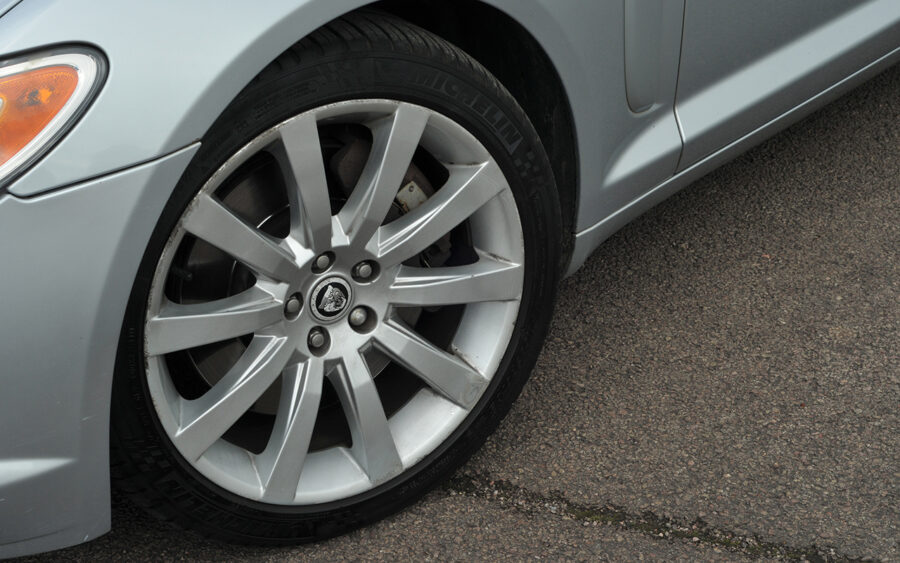
Elite & Performance Jags advises that park brake motor and module failure is becoming a common problem due to age, corrosion inside the wiring or if the wiring fouls another part of the vehicle. Auto Reserve says that one of its best second-hand sellers at present for the Jaguar XF is the brake servo. It takes most mechanics a couple of hours to replace.
The Jaguar XF’s front suspension consists of an engine bed that houses an anti-roll bar with coil-overs, banana-shaped control arms and single lower arms at each front corner. A pair of banana-shaped aluminium uprights extend up into each front wheel arch to attach to a wishbone upper arm, which is secured to each suspension turret. This design is similar to many other Jaguars, including the S-Type, XJ of the same era and the F-Type.
The front-most bush inside the banana-shaped control arm can wear. Use a pry bar to check for excessive play in the front bush. A new bush can be fitted two or three times into the housing, or a new non-genuine arm costs around £170.
The coil-over’s lower mounting bush can wear and result in a knocking noise when driving. Expect to pay around £40 for a new bush. Other bushes that wear include the lower wishbone’s inner bush, the anti-roll bar’s D-bushes (mounting bushes) and the ARB’s drop-links. If the upper wishbone’s ball-joint or inner bushes become worn, budget for around £145 for a new, non-genuine assembly, or £225 for an OE-specification Lemfőrder wishbone.
The rear suspension consists of an upper wishbone, a more complicated lower arm, coil-overs, track control arms (to alter rear-wheel alignment) and an anti-roll bar. Self-levelling air suspension replaces the coil-overs on some models, such as the Sportbrake. Use a pry bar to check the bushes for each upper wishbone and lower arm. The lower arm’s rear-most bush has a spherical bearing, which is known to wear and squeak. The other bushes are rubber and can also wear. Budget for around £160-£200 for a new upper wishbone and around £250 for a lower arm.
Worn anti-roll bar drop-links and mounting bushes can cause a knocking noise at the rear of the XF. Budget for around £20 per drop-link, and the same for a set of mounting bushes. Such a noise can also be caused by a worn lower mounting bush for the coil-over, which costs around £25.
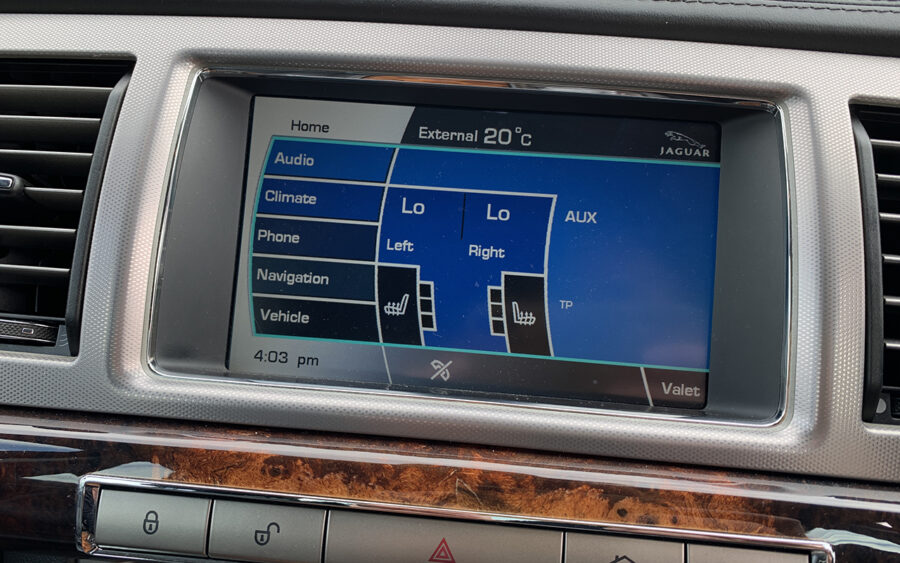
Electrics
The Jaguar XF appears to have an issue with water in the fusebox, resulting in electrical faults and sometimes the need to replace the box entirely. This may be caused by water being drawn up the wiring from the washer pump to the central junction box and fusebox, similar to how a plant draws water. The washer bottle is located inside the offside front wing, and the fusebox is located close by inside the cabin.
One way of avoiding this problem is to cut the two wires, solder them together and wrap them in heat-shrink insulation or insulation tape. Jaguar sells a repair section called a line block, which is fitted to the windscreen washer pump and screenwash level sensor.
Elite & Performance Jags has discovered that the wiring loom routed into the boot can become damaged and worn, resulting in problems and failure of the rear camera, boot lights, numberplate lights and boot release.
Auto Reserve recommends testing the stop-start battery (the smaller of the two batteries in the boot), as this can have quite a hard life and fail within five years.
The resettable Service Required warning display is open to abuse because the car’s warning systems have no way of knowing if the oil has been changed, for example, or with the relevant filters. Matt Norbury at North Wales Jag Centre explains that he regularly receives calls from Jaguar owners who’ve had their vehicle serviced by someone, but still need the service light resetting: “It’s one of the few things we won’t do, no matter who is asking,” he says. “The later models need more than just a service light reset. They also need an oil quality/oil dilution reset as well as resetting the service due message.”
If you know the car has been properly serviced, you can reset the Service Required warning, displayed between the speedo and tacho, by pressing the buttons for the rear fog light and tripmeter in a specific order. With the ignition switched off, press and hold the rear fog light button, then switch on the ignition and release that button.
Next, press and hold the tripmeter button, then press and hold the rear fog light button – both buttons should now be held down. Eventually, a resetting service message will appear on the instrument display, but keep the two buttons held down until a service mode reset message is displayed.
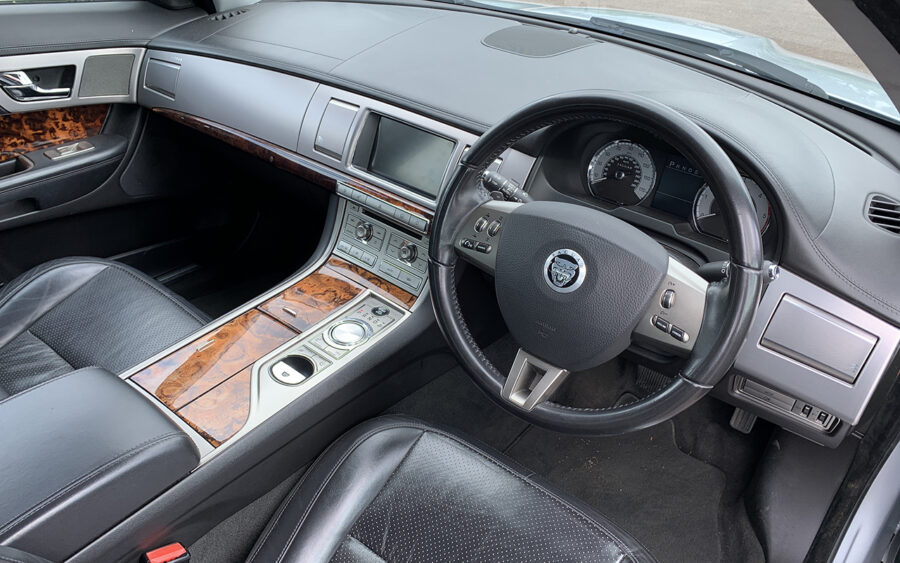
Interior
Vents automatically open and close when the ignition is switched on and off, but the motors that operate them can fail. A used replacement, comprising vent, motor and body, can be had for around £50.
Tom Lenthall Ltd has discovered that the infotainment system can develop problems, often caused by water ingress under the front passenger’s seat. The water can damage most system modules, such as the Bluetooth, audio and DAB modules.
Auto Reserve has discovered the key fobs (2011 onwards) can be troublesome. The chrome trim can easily break off if the keys are dropped, leaving the emergency key at risk of falling out. Fit a rubber sleeve over it if this happens.
Door latch and window regulator failure on the Jaguar XF appear to be a common problem, as suggested by used units from second-hand parts stockists (such as Auto Reserve and Eurojag) being popular sellers.
If a door constantly refuses to lock or unlock via the central locking, potentially the door could become stuck in the locked position. Budget for around £48 for a used door latch, or £120 for a new unit.
Window regulators that stick or struggle to wind the door glass up and down might be encouraged by lubricating the guides. If not, a used regulator (motor and mechanism) costs around £60, a new one around £100. Elite & Performance Jags fits new locks and regulators to avoid the problem reoccurring.
Jaguar XF X250: our verdict
As with most aging modern-era cars, there’s plenty to keep an eye out for when buying a Jaguar XF – it pays to focus on examples with excellent service histories rather than chancing it with down-at-heel cars.
Find a good XF and you’ll be very happy with its excellent blend of performance, handling and effortless cruising ability. Sometimes overlooked on the used market in favour of its BMW, Audi and Mercedes rivals, the first-gen XF is a bargain by comparison and well worth your attention.

